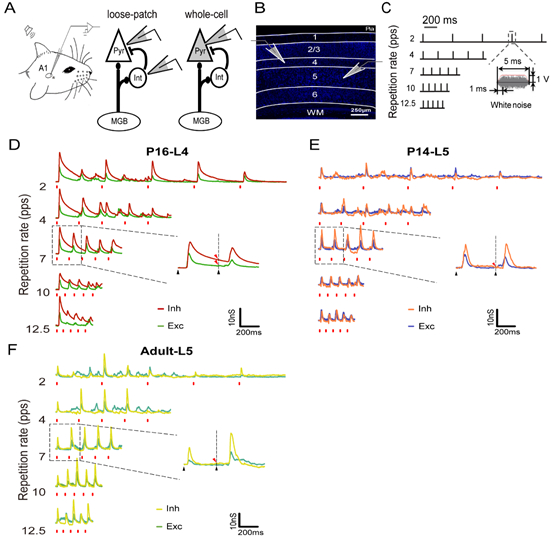On October 30, 2017, Kexin Yuan research group of Department of Biomedical Engineering, School of Medicine, Tsinghua University, IDG/ Mcgovern Institute for Brain Research and Center for Brain-Inspired Computing Research published the paper online named ‘Fast Inhibitory Decay Facilitates Adult-like Temporal Processing in Layer 5 of Developing Primary Auditory Cortex’ in Cerebral Cortex.
The protracted maturational process of temporal processing in layer 4 (L4) of primary auditory cortex (A1) has been extensively studied. Accumulating evidences show that layer 5 (L5) receives direct thalamic inputs as well. How the temporal responses in L5 may developmentally emerge remains unclear. Using in-vivo loose-patch recordings in rat A1, Kexin Yuan lab found that putative pyramidal (Pyr) neurons in developing L5 exhibited adult-like stimulus-following ability but less bursting shortly after hearing onset. L5 Pyr neurons in adult A1 exhibited phase-locking similar to L4 neurons, while L5 fast-spiking (FS) neurons showed greater phase-locking at 7 and 12.5 pps. In developing L5, whole-cell recordings revealed inhibition with decay constant comparable to that in adult L5, thereby avoiding the summation of inhibition that contributed to the strong adaptation in L4. Given the targets of L5 outputs, the relatively precocious temporal processing in L5 might contribute to temporal response maturation in connected cortical and subcortical areas. These findings were in agreement with the idea that L5 may be a “hub” for processing cortical inputs and outputs that can operate independently of L4.

A-C: Schematic of electrophysiological recordings from rat A1.D-F: Example synaptic temporal inhibition (Inh) and excitation (Exc) evoked in developing L4, developing L5 and adult L5 neurons, respectively.
The functional implication of their observations may be three folds. A considerably simplified diagram for L4 and L5 connectivity in the developing A1 is shown. It is widely known that L5 is a prominent output layer of the cortex and Pyr neurons in L5 project to both intracortical and subcortical targets. First, intracortically, L5 neurons provide significant amount of projections to superficial layers 2/3, which has been demonstrated in visual, somatosensory and auditory cortex. Thus, the relatively earlier maturation of temporal processing in auditory cortical L5 might contribute to the development of temporal response in superficial layers. Second, there are strong projections from cortical L5 to striatum, which is implicated in decision-making, action selectionand reinforcement learning. Theoretically, faithful response of L5 neurons in the developing A1 to sound envelopes would provide temporally dynamic inputs to the auditory region in striatum. This might be important for corticostriatal synaptogenesis, whose time window matches that of the critical period of upper cortical layers, and for earlier functional maturation of striatal FS neurons. The third, the higher order thalamic nuclei receive direct inputs from collaterals of L5 corticobulbar and corticospinal neurons and relay information to other cortical areas. Evidences from rats and ferrets suggest that the first cortical projections reach the thalamus at about the same time that thalamic projections reach the cortex, and that L5 projections may be the first to innervate thalamus. Their observations suggested that L5 neurons already had the ability to synchronize with thalamus to distribute corticocortical information during early development, promoting the emergence of integrated global network, and to generate coherent oscillations within corticothalamic network, which was suggested to underlie discrete conscious events.
Students Fenghua Xie and Ling You from the Department of Biomedical Engineering of Tsinghua University are the coauthors of this paper. Prof. Kexin Yuan is the corresponding author. The authors who participated in the part of the experiment also include other students in the research group.
Link: https://doi.org/10.1093/cercor/bhx284

A considerably simplified diagram for L4 and L5 connectivity in the developing A1
